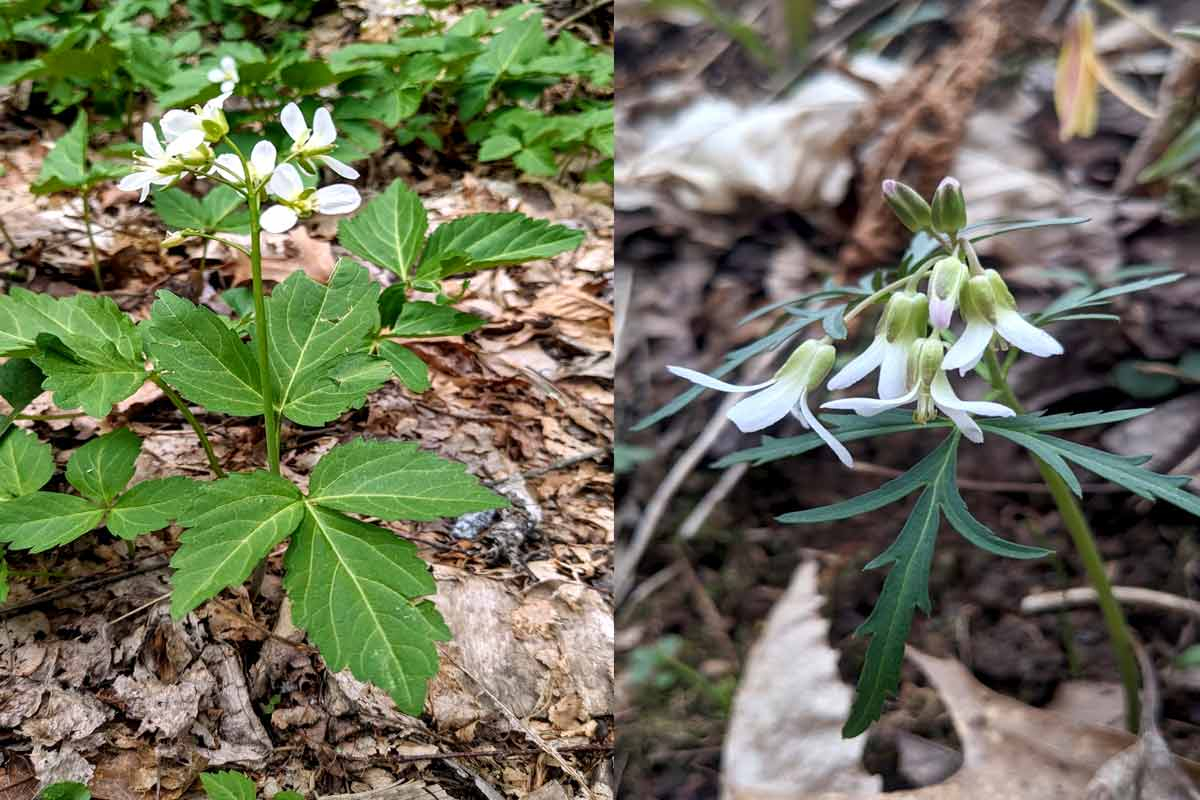Long in the Toothwort
 The common toothwort (left) and cut-leaved toothwort are related species of early spring flowers in the Southern Appalachians. Adam Bigelow photo
The common toothwort (left) and cut-leaved toothwort are related species of early spring flowers in the Southern Appalachians. Adam Bigelow photo
There are three species of toothwort (Cardamine spp.) in the woods of Southern Appalachia, two of which are very common sights on spring wildflower walks. And one that is very rare, and uncommonly seen in the mountains.
Cut-leaved toothwort (Caardamine concatenata) is one of the true spring ephemerals, in that it emerges from the ground in early to mid-spring, makes leaves, produces flowers, gets pollinated, sets and releases seeds, and dies back to the ground, all in the span of a few short weeks. The rest of the year, there is no sign of this plant above the ground, as it lays dormant waiting for its time to bloom again next year.
The leaves of this species are small and wispy and are only found along the stem. These stem leaves are highly dissected, or cut, hence the name cut-leaved toothwort, and have three leaflets per leaf. There are no leaves at the base of the stem or lying along the ground. The flowers are most often white and hang downward, indicating that they are trying to attract pollinators that fly close to the ground or crawl along the ground. Sometimes the flowers of cut-leaved toothwort show up as pink. They are still the same species, just expressing genetic diversity within that species.
The common toothwort (Cardamine diphylla) has leaves along the ground that can be seen all year long. This species also has three leaflets that are much wider and fuller than its ephemeral cousin. Other names for this plant give away its leaf size (broad-leaved toothwort), its family relationship and edibility (turkey mustard) and the shape of its rhizome (crinkleroot). It also has leaves along the stem that resemble the ones found on the ground. The flowers are often smaller and squatter than those of cut-leaved toothwort and are starkly white.
There is a third species of toothwort in the mountains of North Carolina, although it is very rare here, and I’m not sure I’ve ever seen it. It is called slender toothwort (Cardamine angustata) and according to the Vascular Plants of North Carolina database, is much more common in the Piedmont bioregion than it is in the mountains.
Toothworts got their names based on the resemblance of the rhizome root to the teeth of a saw blade. The flowers also look similar to a pulled tooth, roots and all. And, based on the old Doctrine of Signatures — the idea that a plant part’s resemblance to a body part, secretion or ailment indicates how it can be used medicinally — these toothy resemblances indicated that this plant could have a use to help with toothaches. And it turns out that they do. I have used the rhizome of common toothwort to temporarily relieve tooth pain while waiting to see the dentist.
Toothwort roots have anti-inflammatory and anti-bacterial properties. And when you have a toothache, it is usually due to some food that gets caught in a cavity, which then grows bacteria that causes the gums around the area to inflame, putting pressure on the nerve and causing untold pain. And I’m not sure why this is, but toothaches always seem to begin on a Friday afternoon when the dentist is already out golfing for the weekend. And you have to suffer all weekend long before you can even make an appointment, let alone get in to see the dentist and find relief.
It is then that I recommend looking for the leaves of common toothwort, and if you have permission or own the property where you found them, dig up a plant to find the saw-toothed rhizome. Wash it off, and then gently chew up a piece, place it in the cavity of the inflamed and offending tooth, and find relief. This will help reduce the gum swelling, help reduce the population of bacteria growing there, and therefore help reduce the pain until you can get yourself to the dentist’s chair.
(Adam Bigelow lives in Cullowhee and leads weekly wildflower walks most Fridays, and offers consultations and private group tours through Bigelow’s Botanical Excursions. This email address is being protected from spambots. You need JavaScript enabled to view it..)





